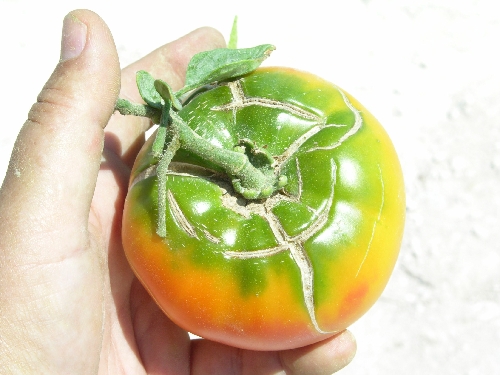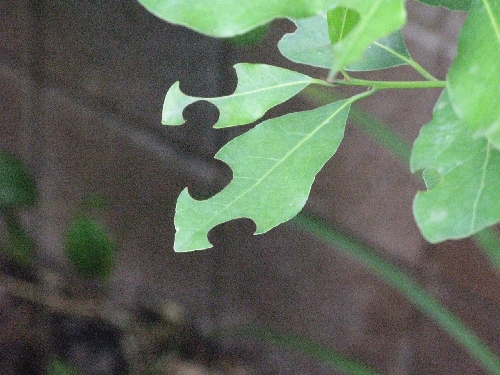Water often to blame for cracked tomatoes
There are now two, new indoor markets available with local produce in two new locations. On Saturdays, you can drop by the Fresh 52 market at Tivoli in the mornings and pick up food grown by some local producers. Starting July 14, if you are downtown or going downtown, stop by Seventh Street and Ogden Avenue on Thursday mornings through the lunch time. You will see local producers with food for sale at the Azul nightclub facing Ogden. For more information email me at Extremehort@aol.com. These are new locations that spun out of the old farmers market on Dean Martin Drive near Blue Diamond Road.
Q: I have this problem. My tomatoes develop cracks at times, usually about half way to maturity. They also rot on the bottom.
A: Tomato cracking can be from the variety of tomato you are growing, it can be how you are managing your irrigations or a combination of both. Rotting of the bottom of the fruit can be caused by irregular irrigations.
Some varieties of tomatoes, particularly heirloom types, are subject to what are called radial cracks. These are concentric, circular cracks around the top of the fruit. These might be reduced by growing them under light shade, probably no more than about 30 percent.
Cracks along the length of the fruit can be a particular problem after a heavy rain. Sometimes when tomatoes are near maturity, very wet soil can result in a lot of water taken up by the plant with lots of it sent to the fruits. The fruit swells and cracks due to excess water .
Use a mulch on the soil's surface to help keep the soil more evenly moist. This can result in less cracking to the fruits because the soil is kept more evenly moist. You can use straw, shredded or even sheets of newspaper or landscape fabric cut into strips as mulch.
Q: Do we have mason bees in Las Vegas? My yard is 50 feet by 25 feet. Do you think it's a good or bad idea having a mason bee house?
A: We don't really have mason or orchard bees that I know of. They are more common to the cooler climates. We rely mostly on leafcutter bees as a wild source of bees for pollination. I sat in the University of Nevada Cooperative Extension Master Gardener Orchard in North Las Vegas for about one hour a few years ago during full bloom and counted bees visiting flowers on a peach trees.
The leafcutters are smaller in size so they are easier to distinguish from Italian honey bees. We have 10 hives of Italian honey bees in the orchard. My best estimate was that about 25 percent of our pollination on that tree was due to leafcutter bees.
I think you would waste your money bringing some mason bees in. I think they might die in this climate. You can make your own leafcutter bee house by drilling holes in a 4-inch-by-4-inch piece of wood or 6-inch-by-6-inch (better) or a tree stump with a three-eighths-inch bit as deep as you can. Five inches is best but drill at least 3 inches deep.
The female bees will lay their eggs in these long tunnels created with your drill bit. The state entomologist in Nevada claims that the longer tunnels will favor the creation of more female bees since the eggs of males are laid the first 3 inches or so of the tunnel. The deeper the hole, the more eggs that turn into females will be laid.
Shallow holes will still provide for the production of bees but male bees will be favored. As we all know, male bees are not as productive workers as females.
You might keep in mind that leafcutter bees will make some damage to some leaves around your yard or garden, but that's OK. They will grow back. Leafcutter bees favor leaves that are smooth and fairly delicate, such as bougainvillea, roses, grapes, basil and the like.
They take these leaves and use them to stuff the tunnels where they pack their eggs. The leaf stuffing used by the bees provides protection for the eggs and food for them to eat as they emerge in a month or so.
Q: I have an African sumac in my backyard that has leaves which turn brown and fall off. I have one in my front yard that does not do that. The one in the back is close to grass that gets 5 minutes of water three times a day. The one in the front is in a rock landscape and gets a lot less water. Is this natural for them or is it getting too much water or not enough fertilizer? The backyard one is on the east side and the one in the front faces west, which is very hot. The one in the back is about 15 years old and about 35 feet tall and wide. Any help would be great.
A: Sometimes they can get so dense that internal shading of the canopy will cause leaves to die and drop. These are fairly messy trees due to leaf drop and dropping of their berries. If the tree in the drier landscape is more open and the tree in the back is more dense, then internal shading of the canopy can be the reason.
Other reasons might include pest problems, such as aphids, which can cause the leaves to be sticky or shiny and drop if there are large numbers of the pest. If the leaves are sticky, try spraying with repeat applications of soap and water or insecticidal soaps. Aphids should disappear during hot weather but reappear again during cool weather. You may also see a lot of ant activity that are working off of the aphids' sugary honeydew droppings.
You can try to open up the canopy with some branch removal (thinning of the canopy by selective limb removal) and admit more light inside the canopy. This, however, will probably cause some suckering on the limbs if too many are removed. You can do some light removal of small branches now. Remove the entire small branch.
Another possibility could be overwatering. If the tree is watered too often, it is possible to develop root rot. Then leaf drop will occur and usually branch dieback.
Q: I have four bushes like the one in the picture I'm sending you. They were planted about six years ago and have never done very well. Each year around this time they look as shown. Can you advise and suggest anything?
A: From the photo, it appears to be Japanese privet that must have soil around its roots that does not go dry. It will not do well in rock landscapes. They do well in a grass landscape. This might be a case of the wrong plant in that location. You would have to increase the frequency of the watering and improve the soil in that location.
The amount of water might also have to be increased. Since I don't know the amount, I would suggest increasing the frequency to about three times a week. The amount depends on the size of the plant but a 3-foot tall plant might require 5 gallons or so each watering. A 10-foot plant might require between 20-30 gallons at each watering.
Bob Morris is a horticulture expert living in Las Vegas. Visit his blog at xtremehorticulture.blogspot.com.


















